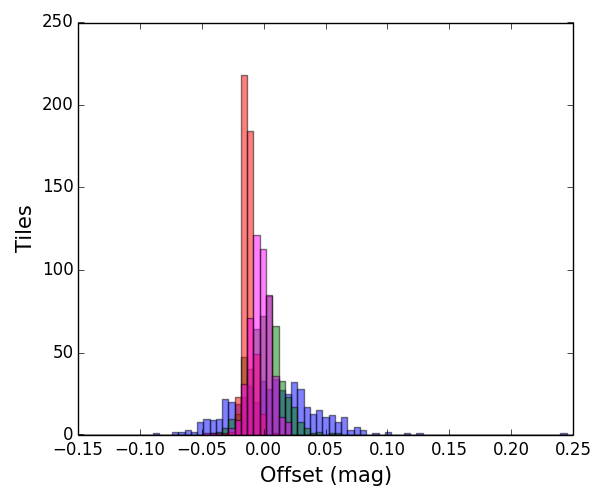KiDS Data Release 4
Welcome to the webpages dedicated to the fourth public data release by the Kilo-Degree Survey (KiDS). KiDS is an ESO public survey carried out with the VLT Survey Telescope (VST) and OmegaCAM camera, that will image 1350 square degrees in four filters (u, g, r, i) in single epochs per filter. The survey is designed to be a weak lensing shear tomography survey, and has as its core science driver mapping of the large-scale matter distribution in the universe and constraining the equation-of-state of Dark Energy. Secondary science cases are manifold and range from galaxy evolution to Milky Way structure, and from detection of white dwarfs to high-redshift quasars.
Data access is provided via the ESO science archive, Astro-WISE and via this website (see the 'Data access' link to the left).
Please see the Acknowledgments page for how to acknowledge
use of data from this release.
KiDS DR 4.1
(April 16 2020)
Due a small bug in the alignment of the mask images during the multi-band catalogue production, a small percentage of sources on 196 tiles has incorrect photometry flags. Updated catalogues for these tiles have been provided as KiDS DR4.1. A file listing the affected tiles can be found here.
Users who have previously downloaded DR4.0 data should download the DR4.1 data only, which supersede the DR4.0 data for these tiles. Users who are new to DR4 data can download the complete release (DR4.1 where it exists, DR4.0 otherwise). We provide links on the Data access page.
Associated data products
The data products in the main data release are complemented by a number of additional data products:
- KiDS-1000 Weak-lensing shear catalogue
- Quasar catalogue
Data access varies per data product type, and the relevant information is available on this website.
KiDS DR4 contents
This fourth data release (KiDS-ESO-DR4) consists of:
- u,g,r,i calibrated, stacked images and their weights, as well as masks and single-band source lists for 1006 survey tiles; this includes reprocessed data from previous release as well as not previously released data.
- a multi-band source catalog for these 1006 survey tiles, featuring Gaussian Aperture and Photometry measurements for 9 bands (KiDS-ugri and VIKING-ZYJHK) and photometric redshifts.
- separate calibrated, stacked r-band images and their weights based on a lensing optimized reduction with the THELI pipeline used for source detection for the multi-band catalog.


|
|
Figure 1: Location of the 1006 survey tiles included in this data release. Tiles also released previous data release are indicated in blue and newly released tiles in green. The final KiDS survey area (top: KiDS-North; bottom: KiDS-South) is shown in grey. |
Intrinsic data quality
The intrinsic quality of the data, quantified by the average PSF size, PSF ellipticity and limiting magnitude per survey tile and split out per filter is shown in Figure 2.

|
|
Figure 2: Raw data quality parameters for the 1006 survey tiles included in KiDS-ESO-DR4. Left: average PSF size (FWHM) distributions; centre: average ellipticity distributions; right: limiting magnitude distributions (5σ AB in 2'' aperture). The distributions are per filter: from top to bottom u, g, r, and i, respectively. |

|
|
Figure 3: 1σ AB GAaP limiting magnitudes for the 9 (KiDS+VIKING) filters provided in the multi-band catalog. The solid red line shows the 50 percentiles and the dashed lines the 1 and 99 percentiles, while the darker and lighter shaded regions enclose 68% and 90% of all sources, respectively. This width is driven by differences in seeing, airmass and sky brightness across the KiDS and VIKING surveys. |
Photometric calibration
New in this data release is that the absolute calibration of the KiDS optical photometry is tied to the SDSS photometric system using Gaia photometry (see Kuijken et al. (2019, A&A 625, A2) for details). First, the u, g and i filters are calibrated to the r-band using Stellar Locus Regression, after which r is calibrated using Gaia. The resulting calibration is very stable, as demonstrated by the comparison of KiDS-North tiles to SDSS DR13 photometry illustrated in Figure 3.

|
|
Figure 4: Distribution of per-tile KiDS-SDSS photometric offsets in KiDS-North. The distributions are per filter: blue is u, green is g, red is r, and magenta is i. |
